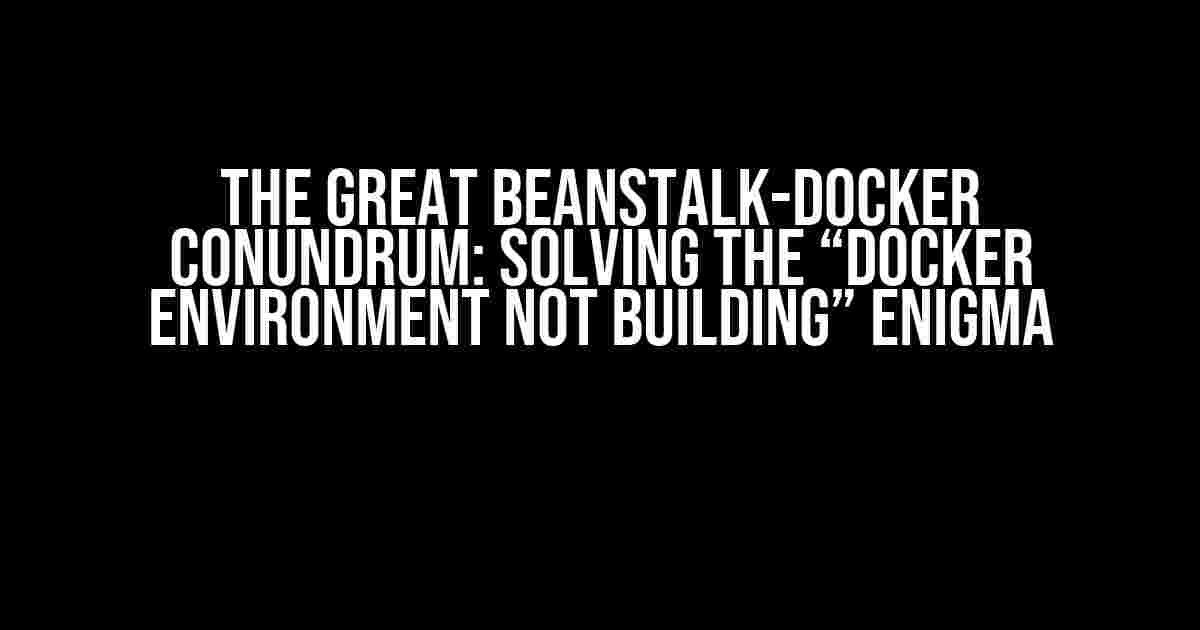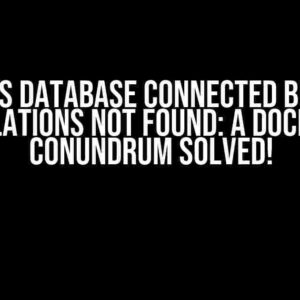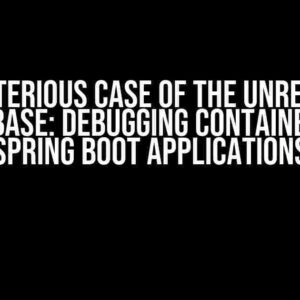Are you tired of pulling your hair out, wondering why your Beanstalk-Docker setup refuses to build your Docker environment, despite it working flawlessly on your local machine? You’re not alone! In this article, we’ll embark on a journey to unravel the mystery behind this frustrating issue and provide you with concrete solutions to get your deployment up and running in no time.
The Symptoms: A Mysterious Refusal to Build
Before we dive into the solution, let’s take a step back and examine the symptoms of this issue. You’ve carefully crafted your Dockerfile, written a spotless docker-compose.yml, and meticulously configured your Beanstalk environment. Yet, when you attempt to deploy your application, Beanstalk stubbornly refuses to build your Docker environment, leaving you with a cryptic error message.
ERROR: Docker Container failed to build: exit status 1
You’ve checked your code, re-read the Docker documentation, and even consulted with fellow developers, but the solution remains elusive. Fear not, dear reader, for we’re about to shine a light on the most common culprits behind this perplexing problem.
Culprit #1: Inconsistent Docker Versions
One of the most common causes of this issue is a mismatch between the Docker version on your local machine and the version used by Beanstalk. It’s essential to ensure that both environments are running the same Docker version to avoid compatibility issues.
To check your local Docker version, run the following command:
docker --version
Next, log in to your Beanstalk dashboard, navigate to the “Container settings” section, and verify the Docker version used by your environment:
| Environment | Docker Version |
|---|---|
| Local Machine | 20.10.7 |
| Beanstalk | 19.03.13 |
In this example, there’s a significant version disparity between the two environments. To resolve this, update your Beanstalk environment to use the same Docker version as your local machine.
Culprit #2: Corrupt or Incomplete Docker Cache
Sometimes, a corrupted or incomplete Docker cache can cause Beanstalk to fail when building your Docker environment. This issue can arise due to various reasons, including network connectivity problems or an interrupted build process.
To resolve this, try clearing the Docker cache on your Beanstalk environment by running the following command:
docker system prune -a
This command will remove all unused Docker images, containers, and volumes, ensuring a clean slate for your build process.
Culprit #3: Incorrect Dockerfile or docker-compose.yml
A single misconfiguration in your Dockerfile or docker-compose.yml can bring your deployment to a grinding halt. Double-check your files for any errors or typos, ensuring that they conform to the official Docker and Docker Compose syntax guidelines.
Take a closer look at your Dockerfile and docker-compose.yml, paying attention to the following:
- Are there any syntax errors or typos?
- Are all dependencies correctly installed and configured?
- Are there any version inconsistencies between packages or dependencies?
If you’ve identified any issues, correct them and try re-deploying your application.
Culprit #4: Insufficient Resources or Timeouts
Beanstalk environments have limited resources, and if your build process requires more resources than available, it may timeout or fail. Make sure to monitor your environment’s resource usage and adjust accordingly.
Additionally, check your Beanstalk environment’s timeout settings to ensure they’re sufficiently long to accommodate your build process.
Culprit #5: Third-Party Service Incompatibilities
Sometimes, third-party services or dependencies can interfere with your Docker environment’s build process. Identify any potential culprits and adjust your configuration accordingly.
For example, if you’re using a CI/CD tool like GitHub Actions or CircleCI, ensure that it’s properly configured to work with your Beanstalk environment.
Putting it all Together: A Step-by-Step Solution
Now that we’ve explored the common culprits behind the “Docker environment not building” issue, let’s create a step-by-step solution to get your deployment up and running:
-
Verify that your local Docker version matches the version used by your Beanstalk environment.
-
Clear the Docker cache on your Beanstalk environment using
docker system prune -a. -
Review your Dockerfile and docker-compose.yml for any errors or typos, and correct them if necessary.
-
Check your Beanstalk environment’s resource usage and adjust the settings according to your needs.
-
Verify that your third-party services or dependencies are properly configured and compatible with your Beanstalk environment.
-
Redeploy your application, and if the issue persists, consult the Beanstalk documentation and Docker logs for further troubleshooting guidance.
By following these steps, you should be able to resolve the “Docker environment not building” issue and successfully deploy your application using Beanstalk and Docker.
Conclusion
The “Docker environment not building” issue can be a frustrating experience, but with a clear understanding of the common culprits and a step-by-step solution, you’ll be well-equipped to overcome this hurdle and deploy your application with confidence.
Remember to stay vigilant, monitor your environment’s performance, and adapt to any changes or updates that may affect your deployment. With these skills and knowledge, you’ll be unstoppable!
Have you encountered any other Beanstalk-Docker conundrums? Share your experiences and solutions in the comments below!
Here are the 5 Questions and Answers about “beanstalk – docker environment not building but it works locally”:
Frequently Asked Question
Got stuck with your Beanstalk Docker environment? Don’t worry, we’ve got you covered! Check out these frequently asked questions to get your Docker environment up and running in no time.
Q1: Why isn’t my Docker environment building on Beanstalk despite working locally?
This could be due to differences in your local environment and the Beanstalk environment. Double-check your Dockerfile, docker-compose.yml, and any environment variables. Ensure that they are compatible with the Beanstalk environment. Also, verify that your Docker version is compatible with Beanstalk.
Q2: How do I troubleshoot the issue with my Docker environment on Beanstalk?
Check the Beanstalk logs to identify the error. You can do this by navigating to the Beanstalk dashboard, clicking on the environment, and then clicking on the “Logs” tab. Look for any error messages that might indicate the cause of the issue. You can also try building your Docker environment manually using the AWS CLI or the Beanstalk API to see if you get more detailed error messages.
Q3: Can I use a different version of Docker on Beanstalk?
Yes, you can use a different version of Docker on Beanstalk. However, make sure that the version you choose is compatible with the Beanstalk platform and your application requirements. You can specify the Docker version in your Dockerfile or docker-compose.yml file. Additionally, you can also configure the Docker version in the Beanstalk environment settings.
Q4: What could be the reasons for a successful build on my local machine but not on Beanstalk?
This could be due to differences in the environment variables, file system permissions, or dependencies between your local machine and the Beanstalk environment. Additionally, the Docker version, base image, or dependencies might be different between the two environments. Ensure that your Dockerfile and docker-compose.yml files are compatible with the Beanstalk environment.
Q5: How do I ensure that my Docker environment is compatible with Beanstalk?
To ensure compatibility, follow the Beanstalk guidelines for Docker environments. Use a supported Docker version, base image, and dependencies. Test your Docker environment on a similar Linux distribution and architecture as the Beanstalk environment. Also, ensure that your environment variables, file system permissions, and dependencies are correctly configured.
I hope this helps!




